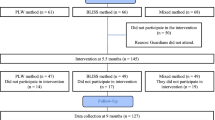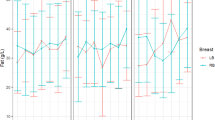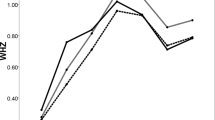Abstract
Objective: To assess the effects of early extra fluid and food intake on breast milk consumption and the effects of food intake on 5-month-old infant nutritional status.
Design: Cross-sectional surveys. Infants were selected by random choice.
Settings: Urban and rural Burkina Faso.
Subjects:A total of 97 urban and 69 rural infants were recruited, but 67 and 51, respectively, completed the surveys. Infant selection criteria were: age (5±0.5-month old), thriving, breastfed, having Burkinabè parents in study area for a year, study conditions accepted by parents.
Interventions: Surveys were conducted respectively in January and February 2001 (urban), and 2002 (rural) during the cool season. They were performed by home visit. With the help of health workers and traditional midwives, families were informed of the studies' objectives and gave agreement. Food intakes were estimated by test-weighing for breast milk and precise weighing techniques for other foods. Socioeconomic status of households, anthropometry of infants and mothers were also recorded. Breast milk samples were collected from each mother's breast and analysed for lipid and fatty acid concentrations.
Results: Daily breast milk intake did not differ between urban (776±262 g) and rural areas (835±265 g). Porridge intake was, respectively, 128±105 and 96±49 g. Median extra fluid intake was, respectively, 79 and 122 g. In both areas, porridge and fluid intake had no effect on breast milk consumption. In urban areas, infant nutritional status at 5 months was better than at birth.
Conclusion: Breast milk intake and nutritional status of predominantly breastfed infants at 5 months of age, living in both urban and rural settings, were not affected by the consumption of extra fluid or food intake.
This is a preview of subscription content, access via your institution
Access options
Subscribe to this journal
Receive 12 print issues and online access
$259.00 per year
only $21.58 per issue
Buy this article
- Purchase on Springer Link
- Instant access to full article PDF
Prices may be subject to local taxes which are calculated during checkout

Similar content being viewed by others
References
Arthur PG, Hartmann PE & Smith M (1987): Measurement of the milk intake of breast-fed infants. J. Pediatr. Gastroenterol. Nutr. 6, 758–763.
Butte NF (1996): Energy requirements of infants. Eur. J. Clin. Nutr. 50(Suppl 1), S24–36.
Butte NF, Garza C, Smith EO & Nichols BL (1983): Evaluation of deuterium dilution technique against the test-weighing procedure for the determination of breast milk intake. Am. J. Clin. Nutr. 37, 996–1003.
De Onis M, Blössner M & Villar J (1998): Levels and patterns of intrauterine growth retardation in developing countries. Eur. J. Clin. Nutr. 52(Suppl 1), S5–S15.
Dop MC (1994): Alimentation des enfants africains: étude méthodologique de techniques d'enquête de consommation alimentaire individuelle, pp 54–81. Thèse, Académie de Dijon, Université de Bourgogne, France.
Dop MC & Benbouzid D (1999): Regional features of complementary feeding in Africa and the Middle East. In Complementary Feeding of Young Children in Africa and the Middle East, WHO/AFRO/NUT/99.4, pp 43–58. Geneva: World Health Organisation.
Dop MC, Milan Ch & N'Diaye AM (1994): The 24-hour recall for Senegalese weanlings: a validation exercise. Eur. J. Clin. Nutr. 48, 643–653.
FAO/WHO (1994): Fats and oils in human nutrition. Report of a joint expert consultation. Paper No. 57, 147p.
FDC/APAIB/WINS (1994): Santé et nutrition des mères et des enfants dans la province du Bazèga, zone d'intervention de FDC/Saponé, 52pp.
Fernandez ID, Himes JH & de Onis M (2002): Prevalence of wasting in populations: building explanatory models using secondary data. Bull. World Health Organ. 80, 282–291.
Hamosh M, Peterson JA, Henderson TR, Scallan CD, Kiwan R, Ceriani RL, Armand M, Mehta NR & Hamosh P (1999): Protective function of human milk: the milk fat globule. Sem. Perinatol. 23, 242–248.
INSD & Macro International Inc. (2000): Enquête de Démographie et de Santé—Burkina Faso 98/99, pp 121–134.
Jensen M (1998): Nutritional status of weanlings and socio-economic status of their households in two poor suburbs of Dakar. Master's thesis, Laboratoire de Nutrition Tropicale, ORSTOM, and Royal Agricultural and Veterinary University of Copenhagen, 43pp.
Koné B, Testa J, Lankoandé J & Sondo B (1996): Faut-il promouvoir l'allaitement maternel au Burkina Faso? Etude de la pratique de l'allaitement maternel dans une zone rurale et dans une zone urbaine. Ann. Pédiatr. (Paris) 43, 772–779.
Neville MC (1995): Volume and caloric density of human milk. In Handbook of Milk Composition, ed. RJ Jensen, pp 97–113. New York: Academic Press, Inc.
Norton R (1993): Enquête de consommation alimentaire sur un groupe d'enfants à 4 et à 6 mois dans un quartier de Brazzaville, Poto-Poto, Congo. Mémoire de DESS, Académie de Montpellier, Université de Montpellier II, France, 68p.
Nwankwo BO & Brieger WR (2002): Exclusive breastfeeding is undermined by use of other liquids in rural south-western Nigeria. J. Trop. Pediatr. 48, 109–112.
Pérez-Escamilla R, Cohen RJ, Brown KH, Landa Riviera L, Canahuati J & Dewey KG (1995): Maternal anthropometric status and lactation performance in low-income Honduran population: evidence for the role of infants. Am. J. Clin. Nutr. 61, 1528–1534.
Prentice AM, Goldberg GR & Prentice A (1994): Body mass index and lactation performance. Eur. J. Clin. Nutr. 48(Suppl. 3), S78–S89.
Rocquelin G, Tapsoba S, Dop MC, Mbemba F, Traissac P & Martin-Prevel Y (1998): Lipid content and essential fatty acid (EFA) composition of mature Congolese breast milk are influenced by mothers' nutritional status: impact on infants' EFA supply. Eur. J. Clin. Nutr. 52, 164–171.
Sachdev HPS, Krishna J, Puri RK, Satyanarayana L & Kumar S (1991): Water supplementation in exclusively breastfed infants during summer in the tropics. Lancet 337, 929–933.
Somda JC (1995): Les pratiques de sevrage au Burkina Faso. In L'Alimentation de complément du jeune enfant, eds S Trèche, B de Benoist, D Benbouzid, F Delpeuch. pp 15–26. Collection: Colloques et Séminaires. Paris: ORSTOM éditions.
UNICEF (2000): UNICEF/MEF/BF/Ministère de l'Economie et des Finances -Burkina Faso. Enfants et femmes du Burkina Faso: défi et espoir, 139pp.
Van Steenbergen WM, Kusin JA & Van Rens MM (1981): Lactation performance of Akamba mothers, Kenya. Breast feeding behaviour, breast milk yield and composition. J. Trop. Pediatr. 27, 155–161.
WHO (1985a): The quantity and quality of breast milk. Report on the WHO Collaborative Study on Breast-Feeding. Geneva: World Health Organisation
WHO (1985b): Energy and protein requirements. Report of a Joint FAO/WHO/UNU Expert Consultation, Technical Report Series 724. Geneva: World Health Organisation.
WHO (1989): Infant Feeding: the Physiological Basis, ed. J Akre, WHO Bulletin, vol. 67(Suppl). Geneva: World Health Organisation.
WHO (1998): Complementary feeding of young children in developing countries: a review of current scientific knowledge, WHO/NUT/98.1, 228pp. Geneva: World Health Organisation.
WHO (2002): Report of the expert consultation on the optimal duration of exclusive breastfeeding. WHO/NHD/01.09, WHO/FCH/CAH/01.24, 6pp, Geneva: World Health Organisation.
Woodward DR & Cumming FJ (1990): Do ambient temperature and humidity influence the breast milk intake of babies? J. Paediatr. Child Health 26, 347–350.
Woolridge MW, Jackson DA, Imong SM, Yootabootr Y & Amatayakui K (1987): Indirect test weighing, a noninvasive technique for estimating night-time breast milk intake. Hum. Clin. Nutr. 41, 347–361.
Zagré NM, Nkondjock A, Soula A & Kaba I (2002): Retard de croissance intra-utérine: prévalence et facteurs favorisants dans un district sanitaire au Burkina Faso. Cah Nutr. Diet. 37, 183–190.
Acknowledgements
We gratefully acknowledge the Montpellier and Ouagadougou IRD authorities, The Burkina Faso health and scientific research authorities, the University of Ouagadougou, field investigators, and the Cissin and Tanghin-Dassouri populations for their collaboration and warm welcome. Studies were supported by IRD and INRA, France.
Author information
Authors and Affiliations
Corresponding author
Rights and permissions
About this article
Cite this article
Thiombiano-Coulibaly, N., Rocquelin, G., Eymard-Duvernay, S. et al. Effects of early extra fluid and food intake on breast milk consumption and infant nutritional status at 5 months of age in an urban and a rural area of Burkina Faso. Eur J Clin Nutr 58, 80–89 (2004). https://doi.org/10.1038/sj.ejcn.1601752
Received:
Revised:
Accepted:
Published:
Issue Date:
DOI: https://doi.org/10.1038/sj.ejcn.1601752
Keywords
This article is cited by
-
Stunting and its determinant factors among children aged 6–59 months in Ethiopia
Italian Journal of Pediatrics (2017)
-
Stunting, wasting and associated factors among children aged 6–24 months in Dabat health and demographic surveillance system site: A community based cross-sectional study in Ethiopia
BMC Pediatrics (2017)
-
Are infants born in baby-friendly hospitals being exclusively breastfed until 6 months of age?
European Journal of Clinical Nutrition (2012)
-
Prevalence and predictors of undernutrition among infants aged six and twelve months in Butajira, Ethiopia: The P-MaMiE Birth Cohort
BMC Public Health (2010)



